The Development of Travel under the Ocean, Vitamins, The Birth of Suburbia – IELTS Reading Answers
Tackle different question types for the IELTS Reading passage on ‘The Development of Travel under the Ocean, Vitamins, The Birth of Suburbia’ by familiarizing yourself with band 8+ strategies to attempt the full-length test within 40 minutes.
Table of Contents
- Types of Questions in The Development of Travel under the Ocean, Vitamins, The Birth of Suburbia
- IELTS Band 8+ Strategies Attempt the Reading Passages on The Development of Travel under the Ocean, Vitamins, The Birth of Suburbia
- Reading Passage 1 - The Development of Travel under the Ocean
- Reading Passage 2 - Vitamins
- Reading Passage 3 - The Birth of Suburbia
- Answers with Location and Explanation on IELTS Reading Passages ‘The Development of Travel under the Ocean, Vitamins, The Birth of Suburbia’

Limited-Time Offer : Access a FREE 10-Day IELTS Study Plan!
The Development of Travel under the Ocean, Vitamins, The Birth of Suburbia are the three passages for which you will get only 60 minutes to attempt. You will encounter 40 questions of various types for which you need to develop your reading comprehension skills as time is limited. As these IELTS Academic Reading passages are from a full-length test, it is recommended to simulate the exam conditions while answering the questions. In this way, you will become familiar with the exam format and track your progress.
Thinking critically is very important as you attempt these passages because you will need specific strategies for each question type. With practical tips and insights, you will be able to achieve a higher band score. Remember to critically analyze the correct answers against yours to note the mistakes which you might have made. By consistently practicing with such passages, you will be exam-ready.
Connect with our band 9 IELTS Trainers to crack your IELTS Reading in no time! Book a FREE Demo.
Types of Questions in The Development of Travel under the Ocean, Vitamins, The Birth of Suburbia
Since this is a complete test with three passages, you will encounter various different types of questions. Remember that these questions would need specific tricks in order to find the answer. Therefore, you must try attempting the question first without looking at the answer key. In this way, you will be confident for the exam day while avoiding stress.
Here are the question types in this reading test:
Reading Passage 1 - The Development of Travel under the Ocean
- IELTS Reading Short Answer Questions [Q.1 - Q.6]
- IELTS Reading Diagram Completion [Q.7 - Q.13]
Reading Passage 2 - Vitamins
- IELTS Reading Multiple-Choice Questions [Q.14 - Q.16]
- IELTS Reading Yes, No, Not Given [Q.17 - Q.21]
- IELTS Reading Matching Features [Q.22 - Q.26]
Reading Passage 3 - The Birth of Suburbia
- IELTS Reading Matching Information [Q.27 - Q.31]
- IELTS Reading Yes, No, Not Given [Q.32 - Q.38]
- IELTS Reading Multiple-Choice Questions [Q.39 - Q.40]
IELTS Band 8+ Strategies Attempt the Reading Passages on The Development of Travel under the Ocean, Vitamins, The Birth of Suburbia
As you indulge yourself with the full-length IELTS Reading passages on ‘The Development of Travel under the Ocean, Vitamins, The Birth of Suburbia’, it is crucial to consider a targeted approach. With these 40 questions, you will be able to identify your weaker areas and work on them. By following a few IELTS Exam Preparation Tips for Band Score of 8+, you are one step closer to achieving your desired band scores. Let’s check out these IELTS Band 8+ strategies!
- Always begin by reviewing the question types so that you can become aware of the techniques to be used to spot the information in the passage. In this way, you will be reading with purpose rather than wasting your time.
- Effective reading under pressure is a skill which you want to develop, especially when you attempt full-length test papers. In this way, you get an idea as to how you would perform in the real exam.
- Use the timer on and do not pause in between passages since Time Management for IELTS Reading plays a crucial role.
- Learn the skimming and scanning techniques so that you can spot the information in the passage easily while understanding the overall meaning of the paragraph.
- Spend one minute per question so that you can complete answering all of them within 40 minutes. The remaining 20 minutes can be used to go through the passages so that you get an idea of the paragraphs.
- All the questions will be paraphrased so it is necessary to understand the meaning of the questions. It is important for you to become aware of How to Ace IELTS Reading with 'Keyword Technique'.
- Spend some time to recheck and review your answers while focusing on the spellings as well. Remember that wrong spellings would affect your band scores as your answers will not be considered.
- For multiple choice questions, use the elimination technique where you eliminate the options which are not relevant to the question. This would narrow down the options and help you in finding the correct ones.
Curious to know how to select the right option for Multiple Choice Questions? Check out the video below!
Reading Passage 1 - The Development of Travel under the Ocean
The Development of Travel Under The Ocean
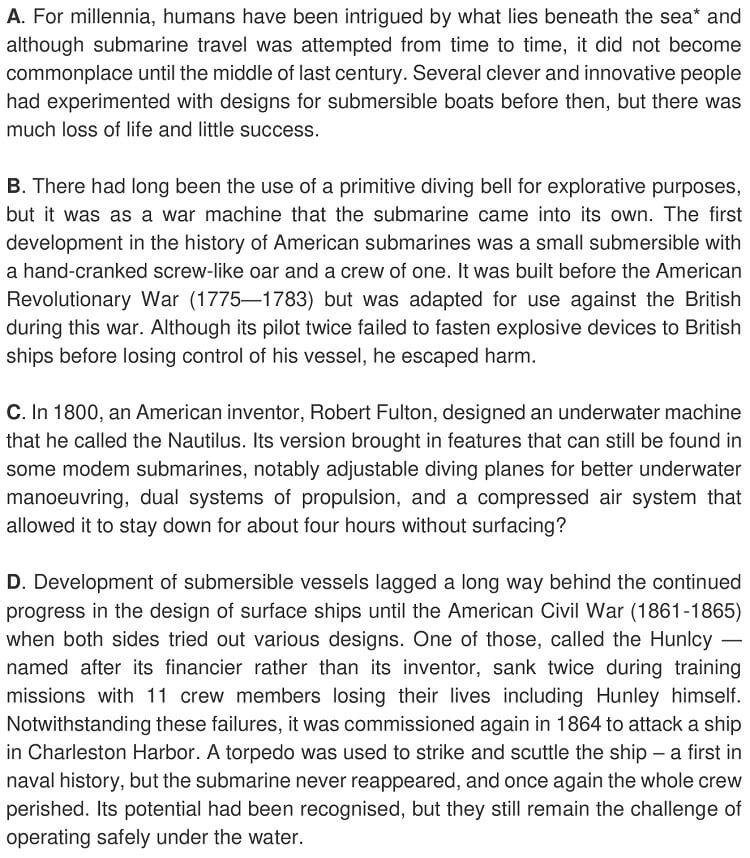
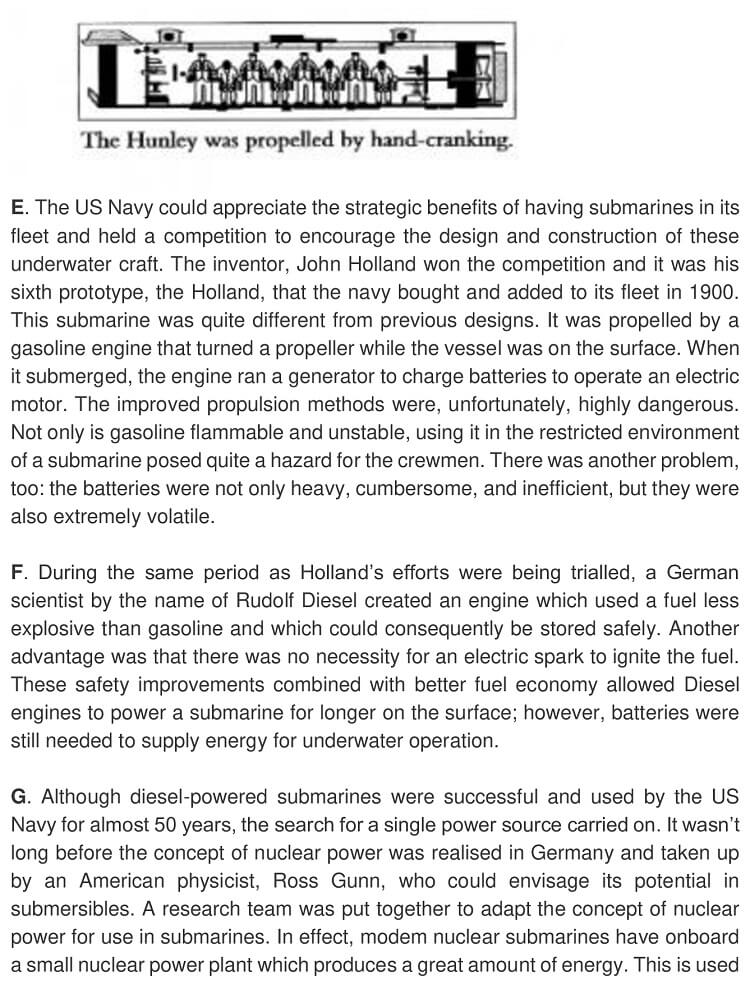
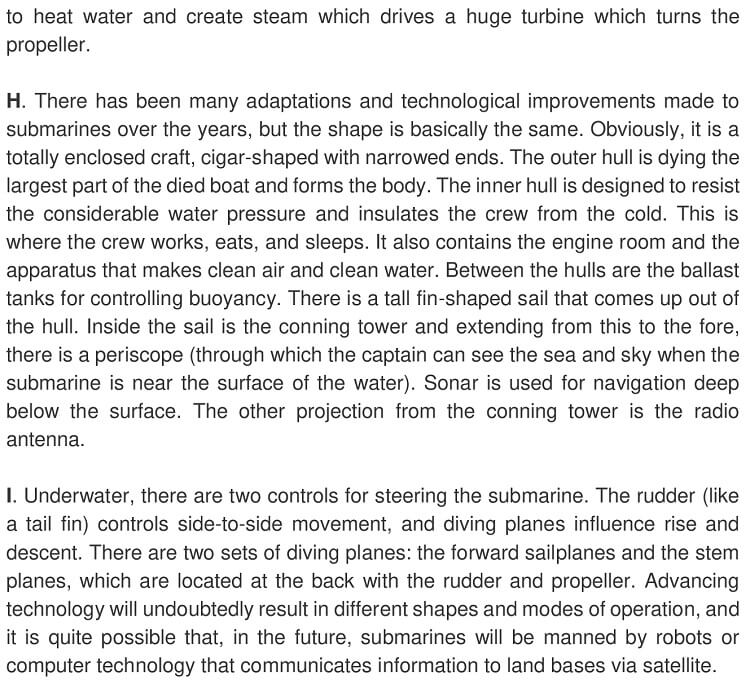
Questions 1-6
Answer the questions below.
Choose NO MORE THAN THREE WORDS from the text for each answer.
Write your answers in boxes 1-6 on your answer sheet.
1 What kind of underwater device was used to investigate the ocean before submersible boats were invented?
2 What was the crewman of the first American-built submarine trying to do before his mission failed?
3 What gave the Nautilus the ability to remain submerged for a long time?
4 When was a submarine first used successfully to sink an enemy boat?
5 What new type of propulsion did Holland use on top of the water?
6 For what reason was Diesel’s fuel considered safer than Holland’s?
Questions 7-13
Label the diagram below.
Choose NO MORE THAN TWO WORDS from the text for each answer.
Write your answers in boxes 7-13 on your answer sheet.
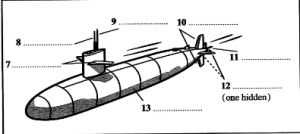
7
8
9
10
11
12
13
Reading Passage 2 - Vitamins
Vitamins
To supplement or not?
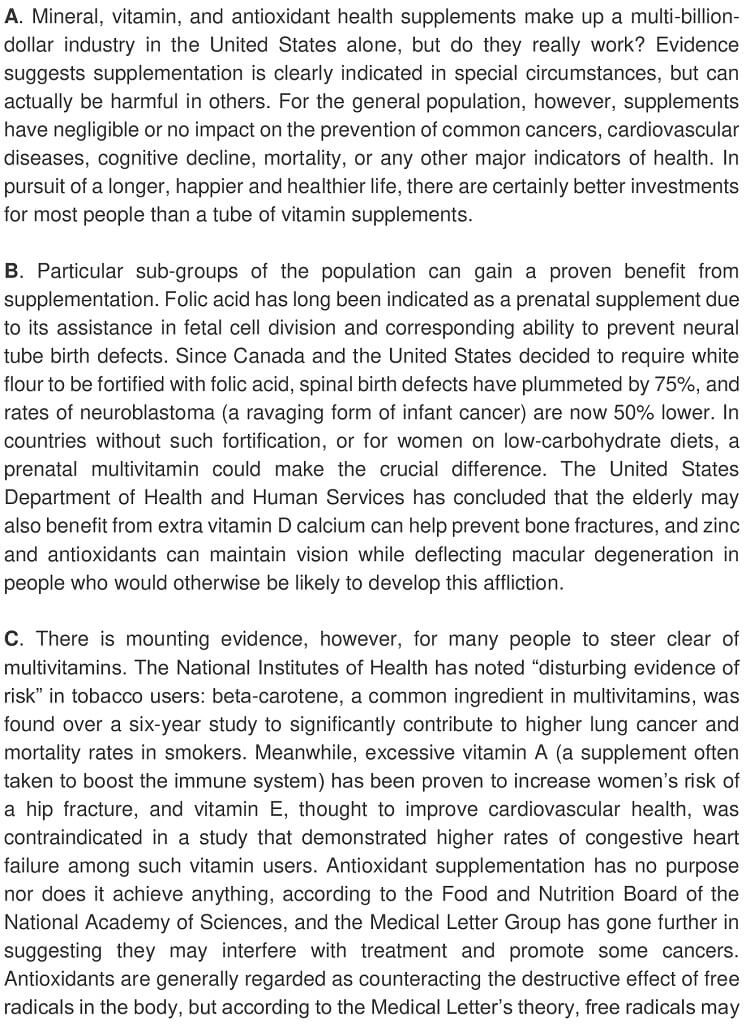
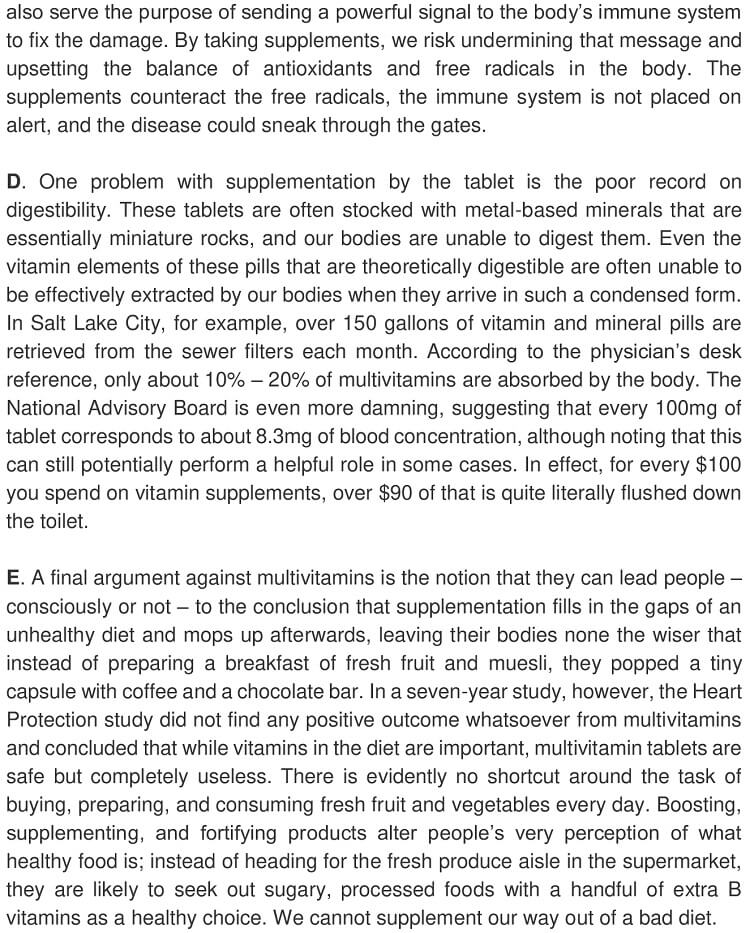
Questions 14-16
Choose, the correct letter, A. B, C, or D.
Write the correct letters in blank spaces 14-16 on your answer sheet.
14 The writer does not recommend multivitamin supplementation for ……………………
A pregnant women.
B young children.
C anyone prone to eye problems.
D old people.
15 According to the writer, vitamin E has been shown to ………………….
A lead to heart problems.
B be good for heart health.
C support the immune system.
D have no effect.
16 The Medical letter Group believes antioxidant supplementation ……………………..
A is ineffective in attacking free radicals.
B alerts the immune system to the presence of free radicals.
C attacks both free radicals and the immune system.
D prevents the immune system from responding to free radicals.
Questions 17-21
Do the following statements agree with the information given in Reading Passage 2?
In boxes 17-21 on your answer sheet, write
YES, if the statement agrees with the views of the writer
NO, if the statement contradicts with the views of the writer
NOT GIVEN, if it is impossible to say what the writer thinks about this
17 Some multivitamin tablets have indigestible ingredients.
18 Some individual vitamins are better absorbed than others in a tablet form.
19 Our bodies cannot distinguish food-based from supplement-based vitamins.
20 Multivitamins can lead to poorer overall eating habits in a person’s life.
21 People typically know that fortified processed foods are not good for them.
Questions 22-26
Write the correct letter A, B or C, in boxes 22-26 on your answer sheet.
Classify the following groups of people according to whether they believe.
A the supplementation may have a positive effect
B the supplementation may have a negative effect
C supplementation has no effect
22 The United States Department of Health and Human Services
23 The National Institutes of Health
24 The Food and Nutrition Board of the National Academy of Sciences
25 The National Advisory Board
26 The Heart Protection Group
Reading Passage 3 - The Birth of Suburbia
The Birth of Suburbia
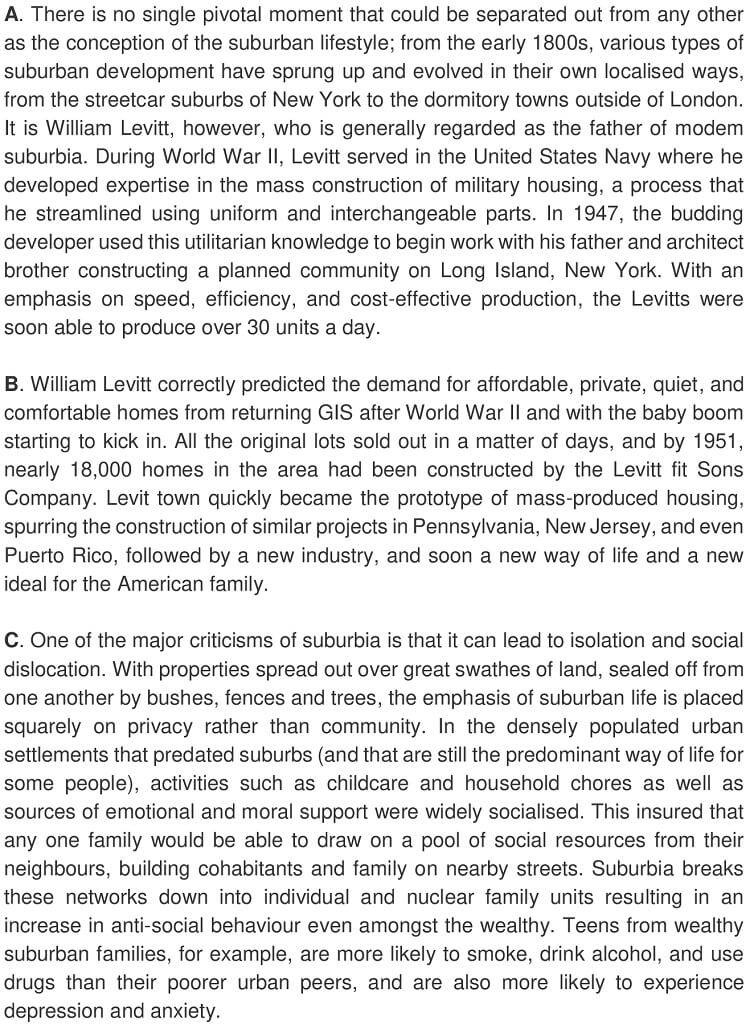
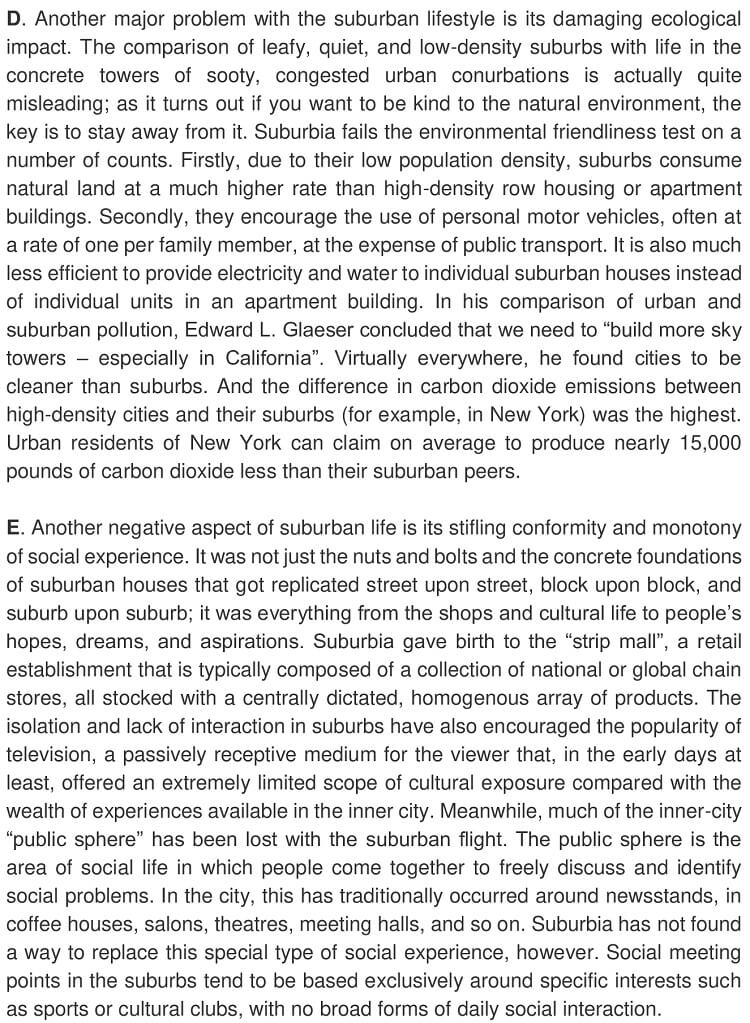
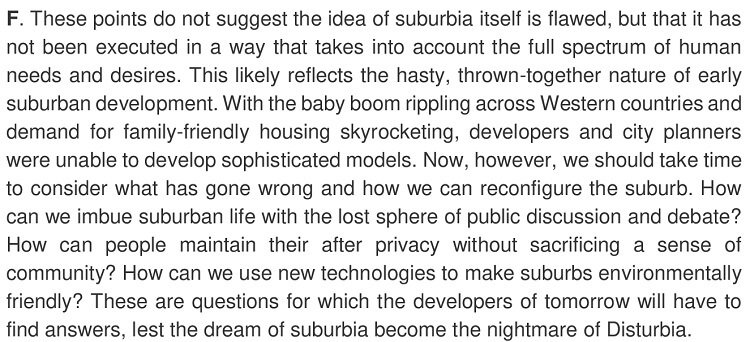
Questions 27-31
Reading Passage 3 has six paragraphs, A-F.
Which paragraph contains the following information?
Write the correct letter, A-F, in boxes 27-31 on your answer sheet.
27 A reason to construct taller buildings
28 Where people might discuss issues of societal concern in urban locations
29 The founder of what is broadly understood as contemporary ‘suburbs’
30 Examples of problems suffered by the youth that suburban lifestyle can make worse
31 A model for suburban development in the latter half of the 20th century
Questions 32-38
Do the following statements agree with the information given in Reading Passage 3?
In boxes 32-38 on your answer sheet, write
YES, if the statement agrees with the views of the writer
NO, if the statement contradicts with the views of the writer
NOT GIVEN, if it is impossible to say what the writer thinks about this
32 A good principle for ecological preservation is to avoid human interference.
33 In some countries, the suburbs are more environmentally friendly than in the USA.
34 Suburban development fosters the use of both public and private forms of
transport
35 People cannot relate to each other in the suburbs because their lives are too
different.
36 There is not much variety amongst the goods at a strip mall.
37 Television has not tended to offer the same diversity as urban cultural outlets.
38 There are no ways for people to get together and interact in the suburbs.
Questions 39 and 40
Choose TWO letters, A-E.
Write your answers in boxes 39 and 40 on your answer sheet.
Which TWO of the following does the author conclude?
A The very concept of a healthy suburban lifestyle is problematic.
B The speed of suburban growth has contributed to its imperfections.
C By thinking about human and ecological needs, suburbs can become better places to live.
D Developers will have to think about ways of living that do not require suburbs.
E Suburbs have their downsides, but they are the best way for parents to raise children.
39
40
Answers with Location and Explanation on IELTS Reading Passages ‘The Development of Travel under the Ocean, Vitamins, The Birth of Suburbia’
Let’s now assess the answers to the questions from the passages – The Development of Travel under the Ocean, Vitamins, The Birth of Suburbia – and enhance your reading abilities for a stronger IELTS Band Score.
The Development of Travel under the Ocean Reading Answers (Passage 1)
|
Answer |
Question Type |
Answer Location |
Answer Explanation |
|
1. primitive diving bell |
Short Answer Questions |
Paragraph B, line 1 |
Primitive diving bells were used for exploration before submarines. Hence, the answer is 'primitive diving bell'. |
|
2. fasten explosive devices |
Short Answer Questions |
Paragraph B, 2nd last line |
The pilot of the first American-built submarine attempted to fasten explosive devices. Hence, the answer is 'fasten explosive devices'. |
|
3. compressed air system |
Short Answer Questions |
Paragraph C, last line |
Robert Fulton's submarine stayed underwater for four hours using a compressed air system. Hence, the answer is 'compressed air system'. |
|
4. 1864 |
Short Answer Questions |
Paragraph D, line 3 |
Submarine was first used to attack a ship in 1864. Hence, the answer is '1864'. |
|
5. gasoline engine |
Short Answer Questions |
Paragraph E, line 4 |
John Holland's submarine used a gasoline engine on the surface. Hence, the answer is 'gasoline engine'. |
|
6. less explosive/volatile |
Short Answer Questions |
Paragraph F, line 1 |
Diesel fuel was less explosive than gasoline, making it safer. Hence, the answer is 'less explosive/volatile'. |
|
7. sailplanes |
Diagram Completion |
Paragraph I, line 3 |
Sailplanes are located in the front. Hence, the answer is 'sailplanes'. |
|
8. periscope |
Diagram Completion |
Paragraph H, 2nd last line |
Periscope allows the captain to see the sea and sky near the surface. Hence, the answer is 'periscope'. |
|
9. radio antenna |
Diagram Completion |
Paragraph H, last line |
Radio antenna is another projection from the conning tower. Hence, the answer is 'radio antenna'. |
|
10. rudder |
Diagram Completion |
Paragraph I, line 1 |
Rudder controls the side-to-side movement of the submarine. Hence, the answer is 'rudder'. |
|
11. propeller |
Diagram Completion |
Paragraph G, line 3 |
Propeller is located at the back of the submarine. Hence, the answer is 'propeller'. |
|
12. stem planes |
Diagram Completion |
Paragraph I, line 3 |
Stem planes are located with rudder and propeller. Hence, the answer is 'stem planes'. |
|
13. outer hull |
Diagram Completion |
Paragraph H, line 3 |
Outer hull forms the body of the submarine. Hence, the answer is 'outer hull'. |
Vitamins Reading Answers (Passage 2)
|
Answer |
Question Type |
Answer Location |
Answer Explanation |
|
14. B |
Multiple Choice Questions |
Paragraph B, last line |
Multivitamins benefit parents, the elderly, and those at risk of eye conditions, not young children. |
|
15. A |
Multiple Choice Questions |
Paragraph C, line 4 |
Vitamin E is linked to higher rates of congestive heart failure, suggesting it leads to heart problems. |
|
16. D |
Multiple Choice Questions |
Paragraph C, 3rd last line |
Supplements may counteract the immune response to free radicals, allowing disease to progress. |
|
17. YES |
Yes/No/Not Given Questions |
Paragraph D, line 1 |
Multivitamin tablets often contain indigestible ingredients like metal-based minerals. |
|
18. NOT GIVEN |
Yes/No/Not Given Questions |
Paragraph C, line 6 |
Only general absorption rate (10–20%) of multivitamins is mentioned, not absorption differences among vitamins. |
|
19. NO |
Yes/No/Not Given Questions |
Paragraph D, line 2; Paragraph E, last line |
Our bodies often fail to effectively extract vitamin elements from pills, showing no distinction from food-based vitamins. |
|
20. YES |
Yes/No/Not Given Questions |
Paragraph E, line 1 |
Multivitamins may lead people to adopt poor eating habits thinking they cover dietary deficiencies. |
|
21. NO |
Yes/No/Not Given Questions |
Paragraph E, line 5 |
People wrongly perceive fortified processed foods as healthy, showing lack of awareness. |
|
22. A |
Matching Information |
Paragraph B, last line |
US Department of Health and Human Services supports positive effects of supplements. |
|
23. B |
Matching Information |
Paragraph C, line 1 |
National Institutes of Health identifies supplement risks, especially for smokers. |
|
24. C |
Matching Information |
Paragraph C, line 4 |
Food and Nutrition Board says antioxidant supplements are useless. |
|
25. A |
Matching Information |
Paragraph D, line 5 |
National Advisory Board notes some supplements have helpful roles, despite low absorption. |
|
26. C |
Matching Information |
Paragraph E, line 3 |
Heart Protection Group concludes multivitamin tablets are safe but ineffective. |
The Birth of Suburbia Reading Answers (Passage 3)
|
Answer |
Question Type |
Answer Location |
Answer Explanation |
|
27. D |
Matching Information |
Paragraph D, line 7 |
Reason to construct taller buildings. |
|
28. E |
Matching Information |
Paragraph E, line 6 |
Urban areas and newsstands as public discussion points. |
|
29. A |
Matching Information |
Paragraph A, line 2 |
William Levitt as the founder of contemporary suburbs. |
|
30. C |
Matching Information |
Paragraph C, last line |
Problems like depression and anxiety among suburban teens. |
|
31. B |
Matching Information |
Paragraph B, line 2 |
Model for suburban development in 1951. |
|
32. YES |
Yes/No/Not Given Questions |
Paragraph D, line 2 |
Avoiding nature preserves ecology. |
|
33. NOT GIVEN |
Yes/No/Not Given Questions |
Paragraph D, 2nd last line |
No info on suburban environmental friendliness in other countries. |
|
34. NO |
Yes/No/Not Given Questions |
Paragraph D, line 5 |
Suburbs promote only private vehicle usage. |
|
35. NO |
Yes/No/Not Given Questions |
Paragraph E, line 1 |
Suburban life is socially monotonous. |
|
36. YES |
Yes/No/Not Given Questions |
Paragraph E, line 3 |
Strip malls lack variety in goods. |
|
37. NO |
Yes/No/Not Given Questions |
Paragraph E, line 4 |
Early TV had limited cultural exposure. |
|
38. NO |
Yes/No/Not Given Questions |
Paragraph E, last line |
Suburbs lack broad daily social interaction. |
|
39. B (B/C in either order) |
Multiple Choice Questions |
Paragraph F, line 1 |
Flaws due to neglecting full spectrum of human needs. |
|
40. C (B/C in either order) |
Multiple Choice Questions |
Paragraph F, 2nd last line |
Suburbs can be improved by considering ecological and human needs. |
Enroll into our Free IELTS Webinar and learn more about techniques to improve your reading speed.
Mastering various question types is the key to secure a higher band score of 8+. With consistent practice, you will be able to develop essential reading skills while it boosts your speed in locating answers. By applying targeted strategies, you will build your confidence and become exam-ready for the actual test day.
Check More Reading Passages
Also Check:
Practice IELTS Reading based on question types

Start Preparing for IELTS: Get Your 10-Day Study Plan Today!
Explore other Reading Practice Tests

Kasturika Samanta

Nehasri Ravishenbagam

Kasturika Samanta
Recent Articles

Nehasri Ravishenbagam

Haniya Yashfeen

Haniya Yashfeen

Haniya Yashfeen




Post your Comments
5 Comments